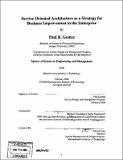Service Oriented Architecture as a strategy for business improvement in the enterprise
Author(s)
Gomez, Paul R. (Paul Robert)
DownloadFull printable version (22.20Mb)
Alternative title
SOA as a strategy for business improvement in the enterprise
Other Contributors
System Design and Management Program.
Advisor
Michael Cusumano.
Terms of use
Metadata
Show full item recordAbstract
The service concepts found in Service-Oriented Architecture (SOA) have been used in software design for many years, with ever-improving tools and a growing understanding of where and how SOA should be applied. Applications built utilizing SOA concepts promote principles such as modularity, distribution, encapsulation and clear interfaces, all core concepts of object-oriented and component-based software development. Despite the clear design advantages of the service concept, most SOA implementations have failed to address many of the issues facing corporations today, including the need for corporate agility, the gap between IT and business, IT project failures and shortcomings in the measurement of business performance.This paper explores the complementary nature of SOA and the core principles of business process management. When combined, these methodologies can help an organization shift to thinking about business processes, map processes to business goals and expose processes as services within the SOA framework. This strategy, when coupled with the abstraction of business flows and rules away from individual applications and infrastructure, has the capability to make the organization more agile, closely aligns IT and the business and enables business performance to be measured and improved. The potential externalization of these business processes can help the organization focus on the needs of customers and partners and promotes the benefits of a virtual organization.
Description
Thesis (S.M.)--Massachusetts Institute of Technology, System Design and Management Program, 2008. Includes bibliographical references.
Date issued
2008Department
System Design and Management Program.Publisher
Massachusetts Institute of Technology
Keywords
System Design and Management Program.